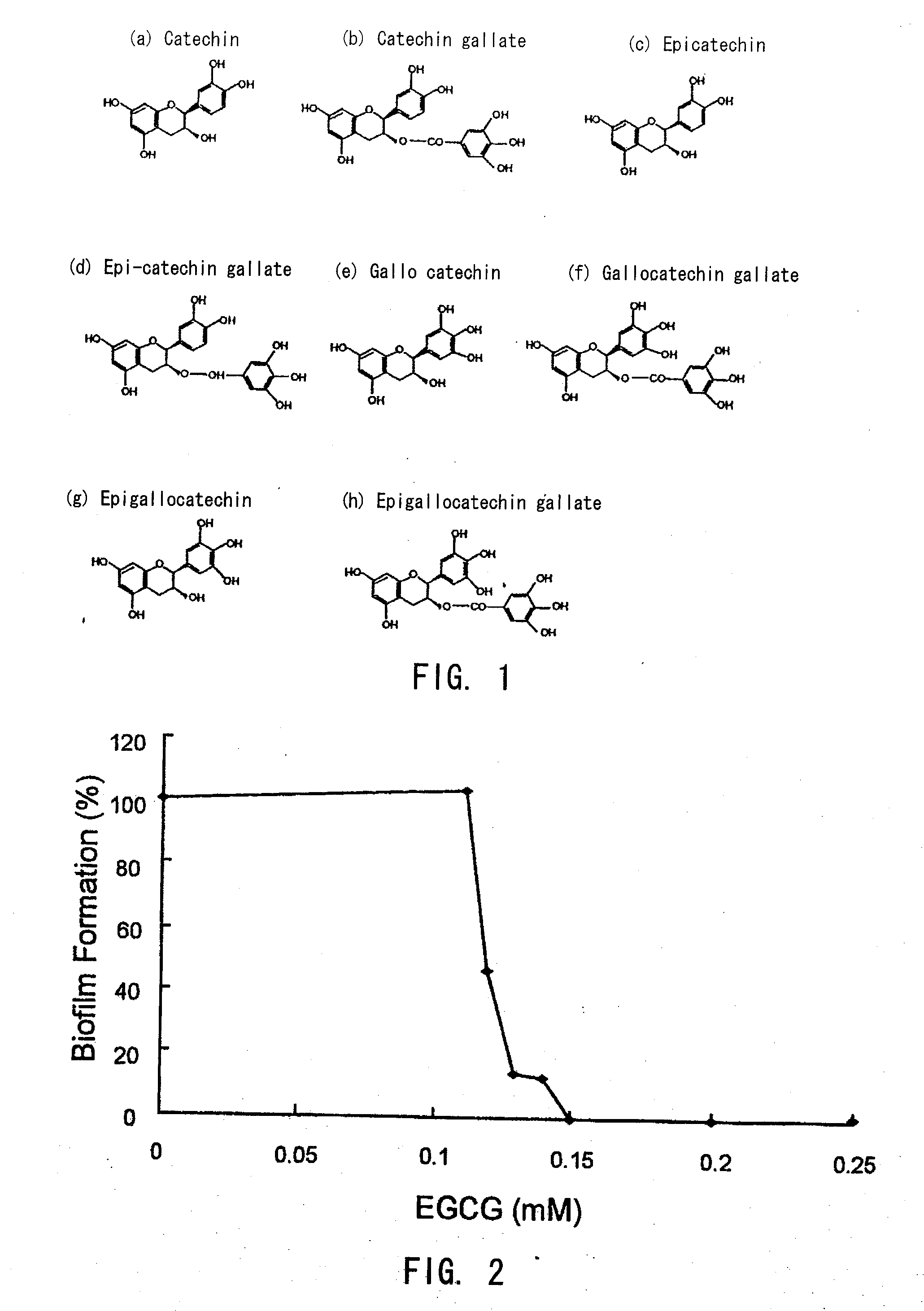Biofilm formation inhibitor and treatment device thereof
a biofilm and inhibitor technology, applied in the direction of antibacterial agents, prostheses, blood vessels, etc., can solve the problems of obstructive jaundice, too late treatment, difficult early detection, etc., and achieve the effect of suppressing the growth of these bacteria and effectively and continuously inhibiting the formation of biofilm
- Summary
- Abstract
- Description
- Claims
- Application Information
AI Technical Summary
Benefits of technology
Problems solved by technology
Method used
Image
Examples
example 1
The Inhibitory Effect of Epigallocatechin Gallate (EGCg) on Biofilm Formation
[0047]8 mm diameter disc shaped polyurethanes were cultured with an E. coli suspension (2×103 CFU / ml) which was mixed with various concentrations of epigallocatechin gallate (EGCg) (0-0.2 mM) under a static condition at 37 degrees Celsius for 24 hours in a culture plate. After incubations, the polyurethane discs were taken out, and having been washed in a phosphate buffer gently, they were moved to a 2 ml phosphate buffer, where they were sonicated to detach the adhered E. coli. Viable E. coli cell counts in the liquid were calculated by the plate count method.
[0048]As shown in FIG. 3 and FIG. 4, epigallocatechin gallate (EGCg) was proved to inhibit biofilm formation significantly at the concentration of 0.12 mM (0.055 mg / ml) and more, and to inhibit completely at the concentration of 0.15 mM (0.069 mg / ml) and more.
example 2
Measurement of Sustained Release Amount of Catechin from Catechin-Loaded Polymer
[0049]Epigallocatechin gallate (EGCg, Sigma—Aldrich, Inc., St. Louis, Mo.: shown in FIG. 3) dissolved in acetone (Sigma—Aldrich) was mixed with three kinds of biodegradable polymers (TMC / LL / PEG1k, TMC / PEG200, TMC / TMP: shown in FIG. 5 (a)-(c)) to make 20 wt % (wt %: weight percent). After acetone was volatilized in a low pressure tank over 24 hours, 250 mg of polymer was coated at the bottom (surface area 1.1 cm2) of a glass bottle, and it was photocured by irradiating with ultraviolet light (SP-V, Ushio, Inc., Yokohama, Japan) for five minutes. 1 ml of phosphate buffer solution (Nissui Pharmaceutical Co., Ltd., Tokyo, Japan) was poured into the glass bottle and stoppered tightly, and kept at 37 degrees Celsius under static conditions for sustained release of EGCg. 100 μl of the solution in the glass bottle was taken out after one, two, and four days, and EGCg levels were calculated by the Folin-Ciocalteu...
example 3
The Inhibitory Effect of Catechin-Loaded Polymer on the Formation of Biofilm by E. coli(Static Conditions)
[0051]EGCg dissolved in acetone was mixed with three kinds of liquid biodegradable polymers (TMC / LL / PEG1k, TMC / PEG200, and TMC / TMP: shown in the FIG. 5 (a)-(c)) to make 0, 5, 10, and 20 wt % (wt %: weight percent). These polymers were spin-coated on polyurethane surfaces, and after having been irradiated with UV for five minutes, and solidified, and 8 mm diameter disc samples were punched out by a belt punch. These samples were incubated at 37 degrees Celsius with an E. coli suspension (2×103 CFU / ml) in a culture plate for 24 hours. After incubation, the samples were taken out and washed in a phosphate buffer gently, and then they were moved to 2 ml of phosphate buffer solution where they are sonicated to detach the adhered E. coli. Viable E. coli cell count in this liquid was calculated by the plate count method.
[0052]These results were shown in FIG. 7 and FIG. 8. According to ...
PUM
| Property | Measurement | Unit |
|---|---|---|
| concentration | aaaaa | aaaaa |
| concentration | aaaaa | aaaaa |
| surface area | aaaaa | aaaaa |
Abstract
Description
Claims
Application Information
 Login to View More
Login to View More - R&D
- Intellectual Property
- Life Sciences
- Materials
- Tech Scout
- Unparalleled Data Quality
- Higher Quality Content
- 60% Fewer Hallucinations
Browse by: Latest US Patents, China's latest patents, Technical Efficacy Thesaurus, Application Domain, Technology Topic, Popular Technical Reports.
© 2025 PatSnap. All rights reserved.Legal|Privacy policy|Modern Slavery Act Transparency Statement|Sitemap|About US| Contact US: help@patsnap.com



